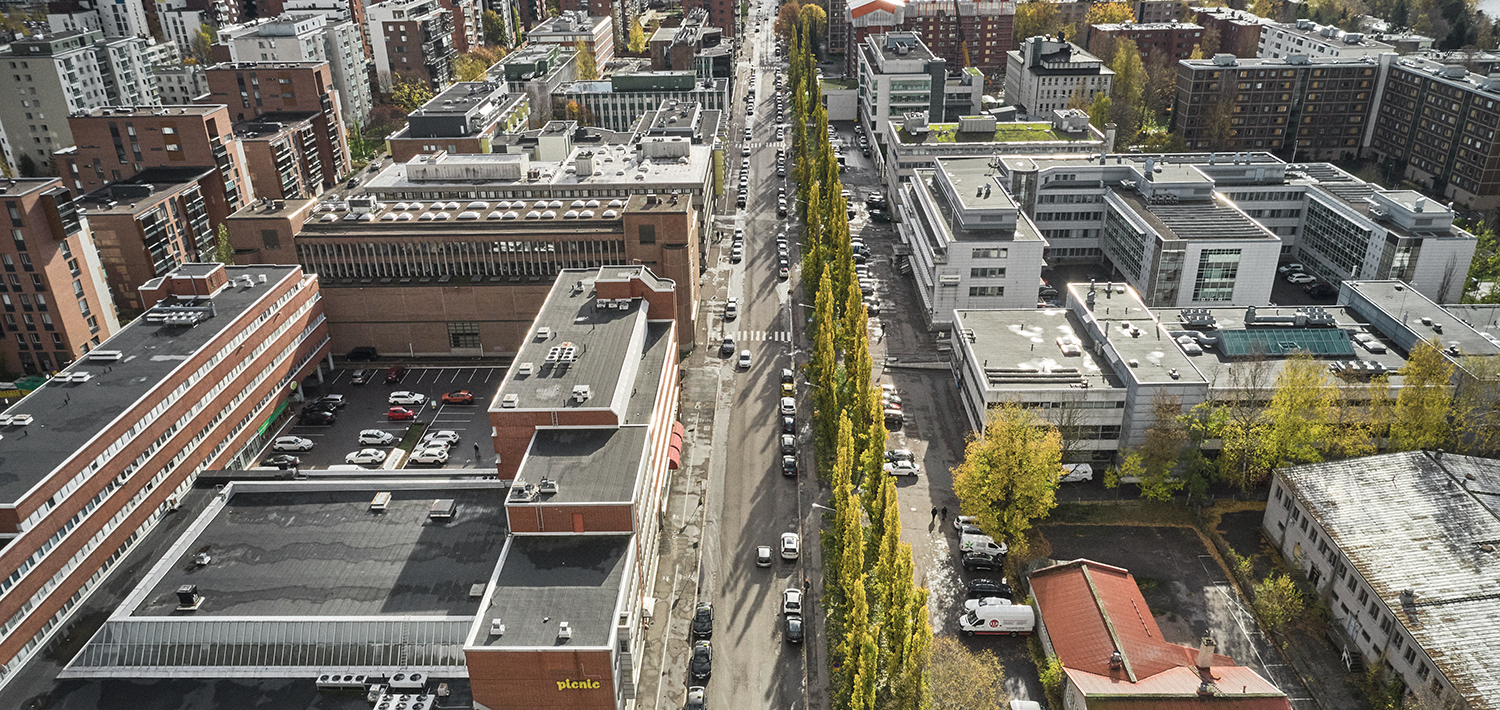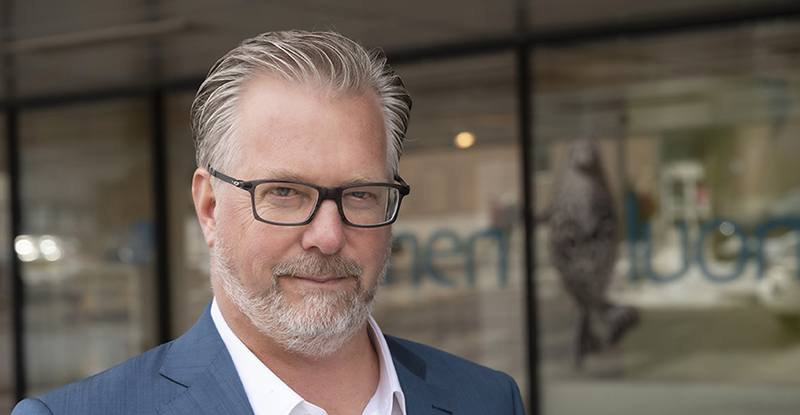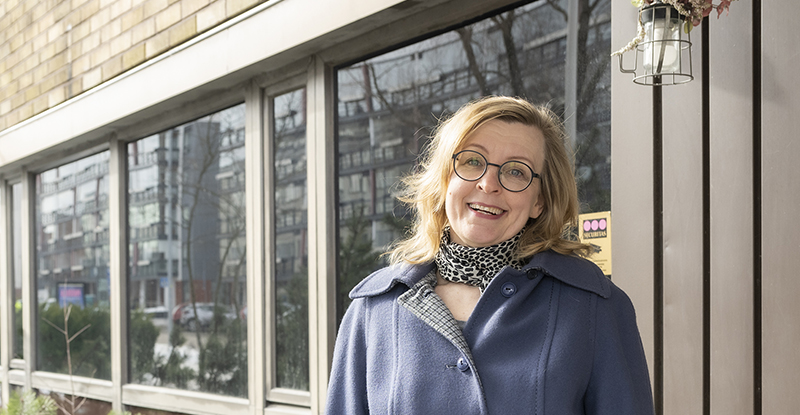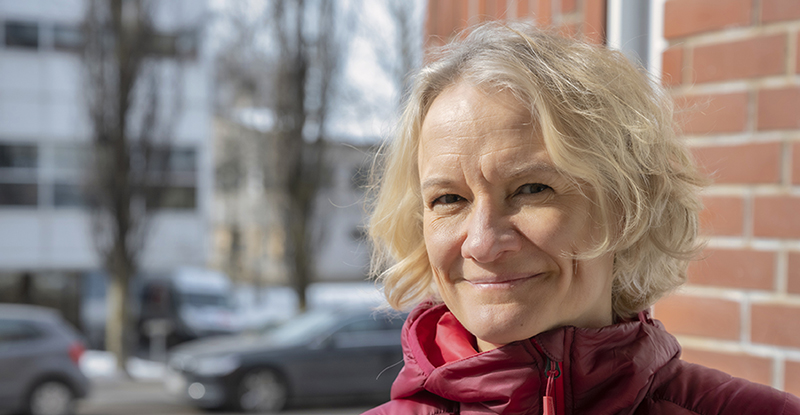Construction boosts circular economy – demolition in Vattuniemi shows the way
The Ministry of the Environment estimates that approximately 1.6 million tonnes of construction and demolition waste is generated every year in Finland. According to the EU’s directive on waste, 70% of this should be reused, but Motiva estimates that the figure stands at only about 50%. This serves as a good reason to promote circular economy in construction, in addition to conserving natural resources and slowing down climate change and loss of biodiversity. The circular economy cluster programme, launched by the City of Helsinki, is also aiming to achieve circular economy in construction.

One of the cluster’s concrete examples is currently being implemented as a development project in Vattuniemi, Lauttasaari, where the plan is to demolish 16 dilapidated properties previously mainly used as offices. The properties are owned by private companies. The aim is to use as much of the demolition material in construction as possible, preferably as it is.
“Demolished properties may contain a lot of similar materials. We will assess whether some materials can be better reused if we combine the material flows. We will also identify possibilities to offer the area’s properties services that facilitate reuse”, says Senior Expert Paula Eskola from Motiva who is coordinating the project.
Participation by the entire construction chain
Skanska is one of the area’s operators and project participants. Skanska Kodit’s Land Acquisition Manager, Teemu Kärkäs, feels it is important that the industry operators are able to enhance their skills and identify circular economy opportunities in Vattuniemi, some of which may remain to be discovered.
“If we can combine the material flows from all 16 properties, they can be utilised more easily. Simultaneously, we can find new business opportunities with the special waste components”, Kärkäs says.
Skanska describes its site as a testing laboratory and a chance to gain new business partners and networks.
SATO’s Project Development Manager, Kirsi Ojala, also emphasises the importance of cooperation. The project in Vattuniemi involves the entire chain: the demolishers, logistics, designers, constructors and authorities.
“Everyone is needed to plan and develop circular economy together”, says Ojala.
She says it is important to be able to see the benefits of circular economy during the project.
“We did not join this project just for the sake of it. We must all be able to see the potential benefits and achievements that await us.”
Development Manager Emma Sallinen from Hartela agrees. She has noticed that operators have been contacting each other more frequently in recent years about circular economy. However, the City’s circular economy cluster is needed to accelerate things.

“Everyone must share the same goal. Otherwise, we will not achieve a change in the industry.”
Emma Sallinen, Hartela
Increasingly helpful data
The City of Helsinki’s circular economy cluster is now particularly focused on promoting circular economy in construction. At the same time, the aim is to promote business operations that follow the circular economy model. Data has been immensely useful: information about the demolished materials is compiled on a shared digital platform.
Nearly all of the operators taking part in Vattuniemi’s project have submitted their demolition surveys, i.e. statements of the amounts and types of demolition materials they expect to generate at a given location. Some of this data has already been analysed and harmonised.
Expert Aki Finér from Motiva says that data collection plays a key part in the project. Information has been passed on to the participants at various events and gathered onto a shared platform. It has been previously noticed that the utilisation of demolition materials is hindered by disparity between supply and demand, as information about current and future availability of materials does not reach the right operators or the information is received too late.
When all the information is made available on a shared platform well before demolition takes place, the materials can be taken into account when planning new construction or passed on to suitable operators, for example in the building product industry.

“We are currently at the coaching phase, talking to the operators about their goals with the demolition projects.”
Aki Finér, Motiva
One of the benefits of Vattuniemi’s project is the large size of the condemned properties. This will result in tremendous amounts of materials. According to estimates there will be 170,000 tonnes of concrete alone, which equals roughly 3,400 lorries.
During the project, the plan is to assess how useful the management, analysis and sharing of data is to different operators.
New use, same location
Elli Kinnunen from A-Insinöörit, who has analysed the demolition surveys and run coaching events, says that over the spring the plan is to assess what each participating operator’s circular economy goals mean in practice. If the intention is to utilise 90% of the demolition materials, they will review what this percentage will include and how it will be achieved.
In addition to concrete, the demolition sites will provide wood, for example. During the project, the aim is to assess how these materials can be sensibly reused in the local area, even on the same piece of land.
Not all properties will be demolished simultaneously. Information about materials available at any given time will be added to the digital platform’s timeline for operators who are about to start constructing new buildings. This information will also be passed on to other users of demolished materials working in the sector.

“The intention is to identify the partners, stakeholders and authorities important to each participant. The circular economy cluster has comprehensive networks for this purpose.”
Elli Kinnunen, A-Insinöörit
The plan is to help the operators plan and carry out pre-demolition work next autumn, provided it suits their schedules.
Eskola from Motiva points out that the key is to collect various parts during pre-demolition. During this phase, parts that can be used as they are, including furniture, electrical equipment, doors and windows, are detached. The work then continues on to the surface structures, such as drywalls and floor materials. Additionally, concrete elements might be suitable for reuse.
Benefits affect responsibility
Careful planning and implementation of a demolition survey takes time. The actual demolition work is also slower when materials are carefully detached for new use.
Kärkäs from Skanska says that the finer the demolition material, the more expensive the work.
“The benefits become evident in the responsibility side of things, and at the same time we can gain vital experience on circular economy solutions for construction projects.”
With great interest, Kinnunen from A-Insinöörit is keeping an eye on the intersection point where environmental responsibility meets the money.
“How much value is assigned to the climate aspects at the expense of costs? Perhaps it is possible to find a point where climate values do not increase the expenses”, she ponders.

Motiva’s Paula Eskola points out that as circular economy becomes more advanced in construction, reuse will also become more efficient and the volumes will rise. Operators will learn to value demolition materials in a new way, and systematic demolition work will no longer cost more. At the same time, circular economy will become increasingly profitable.
For outdoor and storage buildings
Circular economy is by no means a new thing in the construction industry, as all responsible operators have some sustainability goals. As a result, less demolition waste now ends up in mixed waste, although part of the reason is that it would cost money.
Sallinen from Hartela feels that if an operator ignores climate matters and sustainability in general, they run an increasing risk of being excluded. Pop-up events have already been held at demolition sites, allowing all interested parties to look for furniture, lighting units, interior doors and other elements for a very inexpensive price.
Hartela co-owns a plot of land and buildings with Auratum on Heikkiläntie street in Vattuniemi. Hartela intends to demolish the old properties, and design and construct new ones by itself.
“Our strength is that we have our design management and production under the same roof. However, we do not yet know the type of demolition materials that we will be able to use straight away in our new properties”, Sallinen says.
SATO, on the other hand, aims to use demolition materials in outdoor buildings. According to Ojala, the company plans to review whether windows and concrete elements or the old entrance roofing structures could be used to build a storage room for outdoor equipment, for example.
Another participant in Vattuniemi’s project is JMB, which offers rental facilities for companies. The company’s CEO, Joachim Berner, says that JMB’s aim is to find an industrial site where demolition materials from Vattuniemi could be used in the prebuilding of new properties.
“Our plan is to assess whether some of the load-bearing structures could also be utilised in the new construction.”

JMB:n Joachim Berner is pleased that operators are able to promote circular economy during the project. He feels that progress has already been made in the recycling of materials. However, more work is still needed when it comes to utilising used building parts and equipment in their existing forms.
JMB is in the process of hiring someone to carry out the assessment and plan the project’s implementation for the company. The full potential of Vattuniemi’s project is not yet known.
“What we do know is that the scale of its potential is huge.”
Debating adequacy
One of the questions that still remains unanswered is whether demolition materials can be utilised in new construction as they are, based on the current safety standards.
The interpretation of the relevant legislation varies, and questions about adequacy are being debated. So far, the Finnish Safety and Chemicals Agency has taken a hard line.
Kinnunen from A-Insinöörit says that maintaining a high standard of construction quality and safety when utilising demolition materials goes without saying, and it applies to areas such as indoor air and fire safety.
A promising start
Ojala from SATO says that in order to accelerate circular economy, the sector must learn to think in new ways. SATO owns approximately 27,000 homes. Additionally, the renovation of 354 units was completed last year, and 1,100 rental homes were under construction.
She points out that the sector’s operators must learn to take action at a sufficiently early stage. In other words, plenty of time should be allocated to planning demolition work.

“This is good practise for us, and following this process once, twice, will allow us to master it. Doing it alone would be difficult, but sharing the experience with other operators makes it easier.”
Kirsi Ojala, SATO
Ojala feels hopeful. The company has got off to a good start, and things have begun to fall into place. The operators have already learnt that anywhere but a landfill is a good place for demolition waste.
She hopes that residents would also begin to see the value in reused materials, such as building parts that are in good condition, and understand that the approach is about conserving natural resources, not about a need to cut material costs.
Committee to receive amendment proposal this year
The draft amendment proposal for the local detailed plan of Vattuniemi’s centre was publicly displayed in autumn 2021 for views and comments. The amendment proposal was debated by the Urban Environment Committee in November.
The local detailed plan was officially displayed for viewing at the turn of the year.
‘The plan is being prepared to be processed by the Urban Environment Committee based on the objections and statements received. The aim is to present the reviewed proposal to the Committee this year,’ says Architect Paula Kinnunen.

“The feedback on the plan’s environmental goals and the means to achieving these has been nothing but positive.”
Paula Kinnunen, City of Helsinki
“If the Committee approves the local detailed plan’s reviewed amendment and the subsequent land use negotiations with the property owners come to a conclusion, the plan will be submitted to the City Board and the Council for processing. The plan will be confirmed if no complaints are received.”
Residents and other interested parties have given both positive and negative feedback about the plan.
Big business potential
The aim is to use Vattuniemi’s project to create an operating model that can be applied to other demolition sites. Project Manager Mira Jarkko from the City of Helsinki is pleased about the exemplary actions of the participating companies and their willingness to reuse building parts and other elements.

“The City has a circular economy roadmap, and we have made our carbon neutrality objectives increasingly strict. The consumption of virgin natural resources must be reduced, and in order to achieve this we will need everyone’s contribution.”
Mira Jarkko, City of Helsinki
The City has allocated an appropriation for the project. The decision is based on the City’s belief that circular economy in construction possesses significant business potential.
“We hope that Helsinki will gain some global visibility and strength as a city of circular economy. Some signs of this already exist, as we are getting more and more requests for presentations on the theme.”
Photos: Kari Ylitalo and Ilkka Ranta-aho
Helsinki’s cluster programme for circular economy brings operators together to promote the recycling and availability of construction materials and parts. Would your company or organisation like to participate in the cluster’s work? Why not register (form in Finnish only) or contact our experts!

